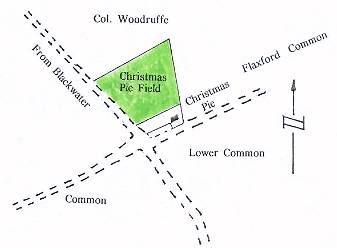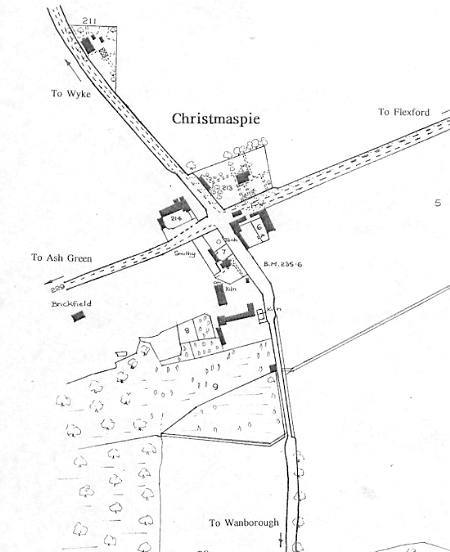| Why is "CHRISTMAS PIE" so
called?
This is another question often asked of Normandy Historians. I have
mentioned before that the Parish of Normandy contains not so much a village
but rather a collection of hamlets strung together. The hamlets are Christmas
Pie, Flexford, Normandy proper centred about the Guildford Road crossroads,
Pinewoods, Willey Green and Wyke.
The curious name of Christmas Pie, which has excited much hurnourous
comment, owes its name to property owned by a prominent local family named
Christmas. There are many references to this family in the Court records
of the Manor of Cleygatc which date back to 1513 in the reign of King Henry
VIII. Christmas's are often noted as serving as members of the Homage which
was the Jury of the Court. The "Pie" part of the name comes from
the Saxon term "pightel" or "pightle" meaning a small
piece of arable land. Until the area was built up during the 1920s there
was a small field called "Pie Field" near the Christmas Pie crossroads.
The parish register of Wanborough dated 1598, records the christening
of three children to John Christmas between 1613 and 1620, namely Edward
in February 1613, Thomas in May 1619 and Joan in September 1620.
 |
Map Christmas Pie 1828 |
Flexford is a corruption of Flaxford (the form shown on old maps) and
derives frorn flax weir or verd meaning flax meadows by a stream. At Little
Flexford Farm there is still a pond in which flax was retted. This term
meant the softening of the stems of flax to allow the fibres to be separated
for the manufacture of linen. This pond has the status of a Grade2 listed
building!
The name Pinewoods is self-explanatory although the woods are now confined
to the rising ground to the north of the main road. This hamlet has always
been isolated from the rest of Normandy by a stretch of open country. It
developed around the former beerhouse called "The Nightingale"
somewhat earlier than the rest of Normandy.
Willey Green is at the lowest point of the parish and was until recently
subject to flooding in bad weather. The name means the place where willow
trees grow. These trees are to be found in damp situations often along
river banks. The hamlet includes the only pub in Normandy, The Duke of
Normandy, but was originally, part of the Parish of Worplesdon and although
parts were nibbled away over the years it was well into the 20th century
before it was formally incorporated into Normandy Parish.
Wyke has the distinction of appearing in Domesday Book where it is recorded
as being a hide held by Godric from Earl Roger. A hide was a somewhat variable
measure of land of approximately 100 acres but in Domesday was used as
a basis for taxation. There is mention of a hall, the site of which was
probably at East Wyke Farm where ancient remains including Surrey White
Ware pottery has been found. The name went through various forms as Wuccha,
Wicca, Week (still preserved in Weekwood), Wick and finally Wyke and the
ecclesiastical parish is that of St.Mark's, Wyke. Until St.Mark's church
was built in 1847 a large section of the parish was a detached part of
St.Mary's at Worplesdon.
I live at Whitepatch Bottom in Normandy Parish. Bottom is the Surrey
word for an area at the base of a hill, very often a marshy valley. In
William Cobbett's day the Devil's Punchbowl at Hindhead was known as High
Combe Bottom. In his "Rural Rides" Cobbett called it "Higginbottom"
which was probably the local pronunciation. Until fairly recently the hill
behind our houses had a prominent white patch near the top as a result
of old gravel workings, hence the name Whitepatch Hill and its associated
Bottom.
| Map Christmas Pie 1871 |
 |
Jack Kinder |